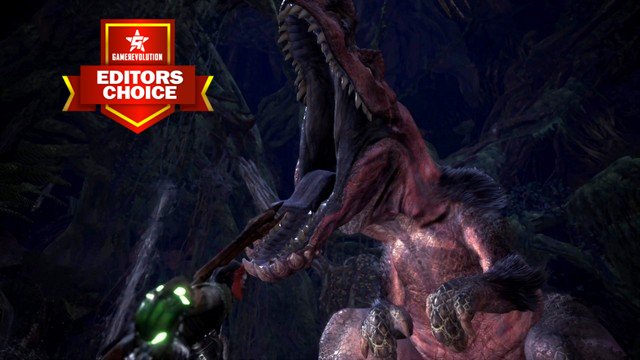Monster Hunter has always been one of those franchises that have really stood on the precipice of becoming a hit in the West. While the series has performed well in its native Japan since its inception, certain aspects have prevented it from being a smash in other territories. That trend started to change with the last few entries on the Nintendo 3DS selling over a million copies apiece in the United States, but it wasn’t until this latest release that the series is finally in a form that makes it approachable for a broader range of gamers.
Monster Hunter World is the first main game in the series since Monster Hunter 3 Ultimate was released in 2012 to release on a console. As much as I love the Nintendo 3DS, it’s plain to see that the franchise needed to move to a more technically capable platform to flourish, and Monster Hunter World uses the increased horsepower of the PS4 and Xbox One to craft a much more intriguing and engrossing world than what we’ve seen previously.
Practically every system of the game has been upgraded over the last 3DS entry (Monster Hunter Generations), and it’s just so much more appealing to play. The New World, to which your hunter is called to explore and tame, is gorgeous, and each animal, from the lowly insects to the gigantic Elder Dragons, have their own unique look and animations that fill the game with character.
Monster Hunter World Review: Wild Hunt
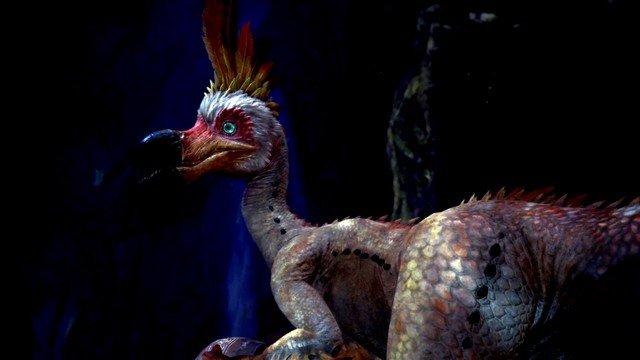
The most prominent improvement in my eyes though is the loading. In the Nintendo 3DS Monster Hunter entries, you had to load between each area of a region, which didn’t lend itself to major hunts across a lot of territories. In Monster Hunter World though, you can bet you’ll cover a ton of ground tracking and fighting each of your targets.
It’s the hunts that take center stage in this game, and all aspects of Monster Hunter World exist to serve this purpose. As you progress through the plot, each large monster you encounter more or less keeps parity with you, so each new species you battle makes for an exciting foe. The plot itself is, well, it’s there. You don’t have to worry about it much, and it mainly serves as a catalyst to propel you into the new world and give you a reason to hunt new monsters.
This game does something I’ve rarely seen before in that you spend so much time on a hunt that you start to feel like you know a monster. Considering it can take 30-40 minutes just to down one foe, you begin to think of them as living creatures who are part of their habitat instead of just some AI enemy for you to cut down.
Sometimes I felt sorry for monsters as I took them down, like the ridiculous Kulu-Ya-Ku, a strange bird/dinosaur creature that is the Jar-Jar Binks of the game. At other times, by the time the fight was almost won I savagely hated these infernal beasts. For example, the damn Tobi-Kadachi with its quick movements and lightning attacks had me cursing it until I finally took it out.
Monster Hunter World Review: Item Grinder
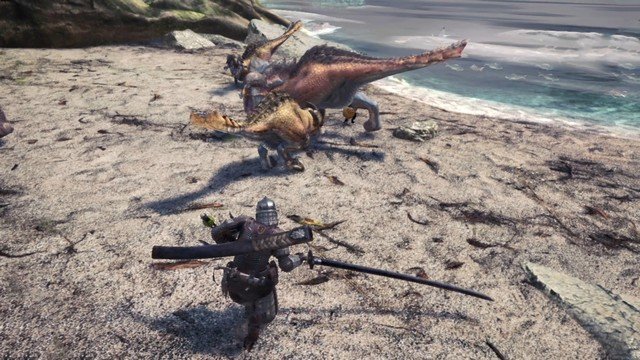
The basic gameplay loop consists of hunting down a large monster so you can use its body parts as material to make weapons and armor to hunt down more powerful monsters. (Almost) every large monster has its own armor set, and each upgrade of your weapons takes parts from more and more powerful monsters.
This isn’t a game you can ignore your equipment in because all of your stats are derived from it. You can’t power level and hope to beat the game with Iron-level weapons because your character doesn’t have a level. Instead, you’re forced to scour the New World for fauna and flora that will enable you to discover and build increasingly powerful weapons.
The item gathering aspect is probably the part of Monster Hunter World that will turn some prospective players off the most. Some items you’ll be able to gather in the same spot over and over, while some are only obtainable by carving them from dead or captured monsters, or in bonus items from a hunt. Luckily you can gain a record of what items are available from each monster by researching them. In Monster Hunter World, each creature leaves its mark on the environment.
So, if you’re hunting a Great Jagras, a gigantic lizard, you’ll find footprints and scratchings throughout the area its traveled. By examining these, you gain research points (and find the location of the creature). The more research points you accrue, the more bonuses you earn concerning a monster and one of those includes an entry in a guidebook telling you what items the beast contains. Fortunately, by “breaking” the body parts of creatures by attacking them repeatedly, you can increase the chance of specific items dropping. However, I can’t say there haven’t been times that I spent 30 minutes or more hunting a monster for an item I needed to craft my next weapon or armor only to have it not appear, which can be incredibly frustrating.
Monster Hunter World Review: Fun With Weapons
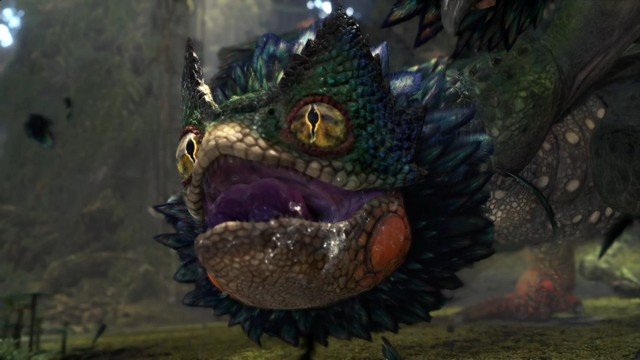
Since combat is such a large part of the game, it’s a good thing that it’s incredibly satisfying. There are 14 different weapons types in Monster Hunter World, and each has its own way of handling that makes it unique. You can’t just pick a weapon at random and start hacking-and-slashing your way through whatever moves. Each type of arm has its own unique abilities and combos that give the game a Dark Souls feel as opposed to handling like Devil May Cry or a more fast-paced game. You have to be deliberate in your attacks and know the strengths and weaknesses of your weapon of choice to hunt successfully in this game.
As you play, you’ll likely try all of the weapons once, and you should. Each player is going to find a core group of weapons they’re happy with and stick with them. With the resources and time sink crafting or upgrading weapons takes it’s only feasible to equip yourself with two or three types anyway. During my playthrough, I stuck with Long Swords (katanas that typically look a lot like Sephiroth’s Masamune) and Insect Glaives.
Long Swords pack a punch but allow you to still be mobile at the expense of the ability to guard. Insect Glaives are quick, will enable you to attack and evade from the air, and give you access to various Kinsects that allow you to use unique buffs for yourself or debuffs for your enemies. However, Glaives also lack the ability to guard, and individual attacks are weak.
Your experience with the weapons system might be completely different though. You may hate the Long Sword and Insect Glaive and instead become an expert with the slow, but mighty Great Sword, or the versatile Sword and Shield. I couldn’t get the hang of those, but that’s another of the extraordinary things about this game, it rewards you for finding your niche and sticking with it.
Monster Hunter World Review: Co-opromise
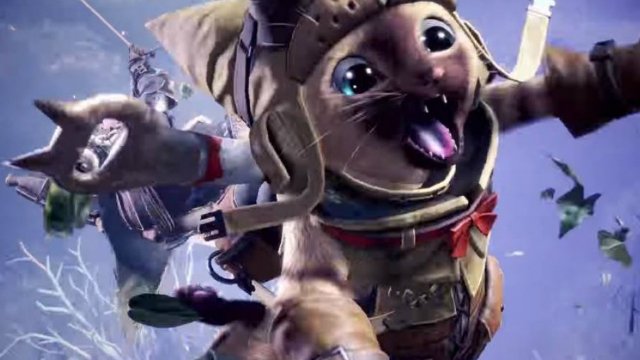
Monster Hunter World has a high focus on multiplayer, but its implementation is so bizarre I spent most of my time in the game hunting alone. What would have been great is persistent drop-in/drop-out sessions. The hub of the game, Astra, is geared perfectly to have multiple players inhabiting it at once, and its scale is such that it feels like an MMO town with plenty of room to run around in.
However, that’s not the case. Instead of getting it chill with your friends on and off the hunt, you can only have other players join you when you’ve accepted and posted a quest. You have to invite a friend, then post a quest, then they have to go to the quest board in their game and join your quest. If you (or they) haven’t watched the cutscenes for that quest, they can’t enter it. So, once you have both watched the cutscenes, there’s a lot of waiting, you do the quest, then you both return to the hub. If you want to go on another quest, one of you has to post it and then join it again.
Paul’s feature on just how convoluted and odd the co-op multiplayer system is in Monster Hunter World goes into more depth about just how weird the whole thing is, and he draws the same conclusion I do. If you want to play with other people, you’re better off starting a hunt and using an item called an SOS Flare which sends a call out for players to come help you. This bypasses the whole quest board convolution and gets someone right into the game with you. Some quests, namely the optional ones like investigations make things a bit easier, but for a game with a focus on co-op, Monster Hunter World makes it a time-consuming and unfulfilling experience.
Monster Hunter World Review: A Beast of a Game
Hunting the beasts of Monster Hunter World was an enthralling adventure, and there’s just so much content in this game that a review can’t hope to encompass it. There are so many systems, side quests, and nooks and crannies this game has that I can’t do it full justice here. You can catch animals to be your pets and watch them in your room; you have a feline pal called a Palico who comes with you and helps you on your way and is the most adorable, and so much more.
Monster Hunter World is bursting with content and is a game that you can easily get over 100 hours in. The downside is that a lot of those 100 or more hours will be by your lonesome. While as a single-player game this title excels, the multiplayer matchmaking can be incredibly clunky and inexplicably doesn’t allow you to stick by another player’s side persistently. However, in a world so vibrant and full of wonderous monsters and environments, questing by yourself is an immensely satisfying experience and once you get the hang of what you can and can’t do in multiplayer, you’ll have plenty of fun with other players. This is the Monster Hunter game that will finally solidify the series in the West in the way it has been in Japan for over a decade and is a terrific experience from start to finish (if you ever truly get finished).
-
A major upgrade over previous entries in almost every aspect.
-
Satisfying and complex combat system.
-
100+ hours of content.
-
Palicos.
-
Grinding for items might be a turn off for some players.
-
Multiplayer matchmaking leaves a bit to be desired.
